A very rare astronomical event just happened on the evening of October 19th: comet C/2013 A1 (Siding Spring) passed only 132000 kilometers from the planet Mars, that is almost a third of the Earth-Moon distance. In 2013, when the comet was discovered, the prediction was still hard to compute, and there was a slight chance of an impact; eventually the ephemeris of the comet position were computed from a longer period of time and the chance of the comet hitting Mars were reduced to zero. Still, the event remained as one of the most impressive for both professional and amateur astronomers.
And luckily enough for our latitude (45N) the event was just visible above the horizon.
For “spying” on this cosmic meeting, I had to travel onto darker skies and a location with a low horizon, in the Comana Woods just south of Bucharest, together with my wife and her brother.
The equipment used: TS APO 115mm F/7 Refractor on a NEQ6 equatorial mount, and an ASI120MM camera with Baader UV/IR cut filter.
Half an hour after the Sun went down I’ve managed to align the mount and prepare the acquisition settings. The first target was to see if the comet could be easily visible onto single 15 second frames; after the very first image, the result was positive, despite the rather diffuse aspect of the comet, and it’s +10 magnitude.
I will start (for now) with two animations showing the movement of both the comet and that of the planet Mars among the stars. Both animations are made up from 151 frames, each a 15 second exposure. Each of them shows a different perspective: the first shows the movement of both objects with a fixed background of stars. The second shows the scene as it would be observed by a space probe moving at the same speed as Mars. The planet is overexposed in all of the following images; the apparent size of Mars is of course much smaller.
I’m still trying to get the best out of these noisy images, so better images might appear later on in this post, but until that moment, I’m posting a few images with this event, with different perspectives.
The first shows the background full of stars and the movement of both the comet and Mars among them:
The second shows the movement of the comet (and that of the stars in the background) with Mars in a fixed position. This is perhaps the correct way to show the comet’s approach to the planet. Only some of the frames were used in the image, and thus the distinct shape of the comet is seen onto it’s trajectory in five positions.
And the last (for now) is an image that shows the actual comet onto a moving background. The strange shape of Mars is the result of the planet’s movement.
All of the above images/animations were acquired during a 50 minute period, from 16:30 to 17:20 U.T.
One of the above animations was posted on the AstroInfo page.
Max
(October 20, 2014)

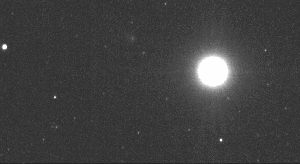
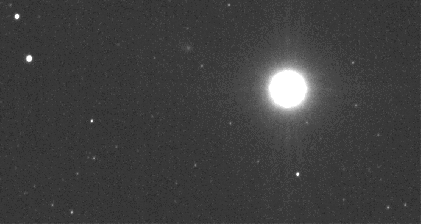
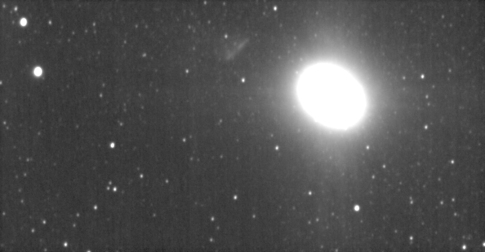
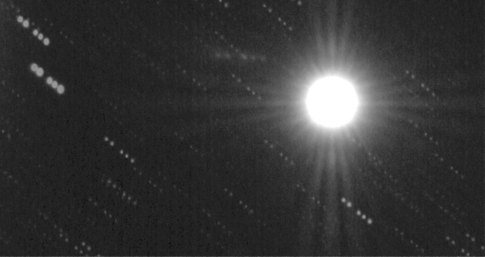
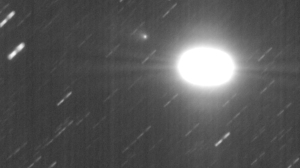
Wow! The dynamics of the scene looks unreal! Incredible images by someone not working in an observatory (and maybe they should :P).. Great to see the 2 perspectives. It’s hard for me not to observe the speed of unfolding events. Is the time span really 151 x 15 sec? Or is there time between the frames? Sorry for Anyway, I can only imagine how it must have been seeing this from Mars surface.. 😐
* i meant to say sorry for the seemingly dumb question about the time 🙂
Thanks Clau! Maybe I will work eventually in an observatory, but it might be mine:). The total exposure was 151×15 seconds acquired on a 50 minute period, with a lot of gaps (visible in the animations) due to some very “happy” moments for me and the Windows on my laptop (read many errors and “nice words” from my part). The question is not dumb since I’m used with the astrophotography nomenclature and don’t realise that sometimes I’m a bit criptic with the information about the images. Glad I could present the event to you, despite the not so perfect conditions from my location (low altitude of the event above the horizon, high humidity, small instrument).
Very nice result! I particularly like the one with fixed background stars, really shows the dynamics of the solar system. Congrats!
Thank you Matei! Yes, that was the main reason why I’ve processed the image in this way. I was actually surprised also about the rapid movement of both objects in such a short period of time…
Amazing images and animation!! I applaud you for the fine work for capturing the Siding Spring and Mars.
Thank you Jim! Glad you like them. I’m still trying to get more from the images of that evening session, so perhaps I will eventually post something new in the post. Thank you for looking!
Hi Max, real great work! I wonder your story about following Mars/SSpring because I did exactly the same.- 15sec delay, around 130 images- .. although inside our observatory—-congratulations, special!
Thank you Gunther! Glad you’ve liked the animations. Only one mention: the frames were each a 15 second exposure with almost no delay between them, except some missing minutes where I was forced to restart the program due to some errors. If you want you can post a link to your animation here for me (and others) to see. Thanks.